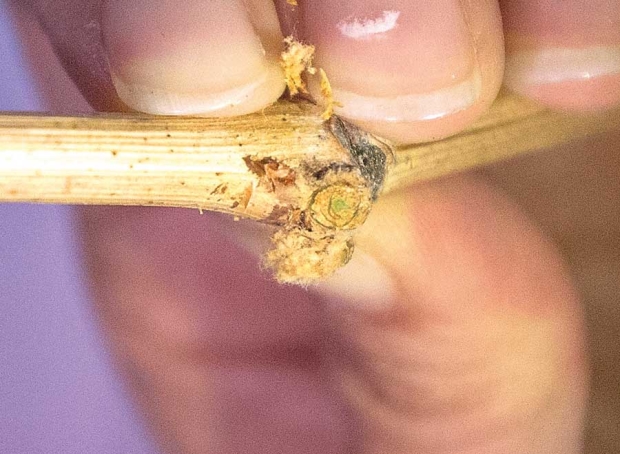
Dr. Michelle Moyer, left, shows Stacy and Greg Letendre how to assess damage to grape buds during the Washington Association of Wine Grape Grower meeting in Kennewick, Wash., on February 11, 2016. Moyer demonstrated a two-cut method of exposing the three buds within the vine during winter. (TJ Mullinax/Good Fruit Grower)
Grapevines require adequate chilling during dormancy for uniform bud break the following growing season, but vines in northern growing areas that are exposed to very low temperatures or sudden extreme low temperatures can be susceptible to damage.
Finding and recognizing the signs of this damage is critical for growers in these regions.
Buds, canes, cordons, trunks and roots can be damaged when temperatures fall below a vine’s particular cold hardiness level, and the vine itself can die. Buds are moderately susceptible to cold damage and cannot be repaired.
However, vines also have a compound bud comprised of primary, secondary and tertiary buds that work as a backup plan.
The phloem (vascular tissue that conducts sugars and metabolic products from the leaves to other plant parts) is most susceptible to cold damage in midwinter, but it regenerates itself annually.
Xylem, the vascular tissue that conducts water and nutrients from the roots to other plant parts, is the least susceptible to cold damage, but xylem damage is more serious because it hinders the vine’s ability to uptake water. Once it’s damaged, it doesn’t repair itself.
Washington State University has developed a cold hardiness model to predict grapevine cold hardiness anywhere temperature data is available.
But each vineyard has its own climate and microclimates, and growers should know as much about their vineyard as possible to make it easier to assess if cold damage is a concern when a cold front hits.
Sampling for damage
Gwen Hoheisel, WSU Extension educator in Prosser, Washington, and Matt Halldorson, viticulturist for Ste. Michelle Wine Estates, offered tips for assessing for cold damage during the Washington Association of Wine Grape Growers annual meeting in Kennewick, Washington, in February.
Growers should consider the number of variables in their vineyards, such as variety, soil types, elevation changes, airflow and cold spots (low-lying areas that would allow cold air to pool).
“Learn your vineyard very well,” Hoheisel said. “The more variables you have in your field, the more samples that you need to take, but samples take time and effort.”
Growers also should identify a critical temperature at which point they suspect their vineyards might be susceptible to damage, then monitor the weather. “If you think you’ve crossed this threshold, if you’ve gotten close, it’s worth assessing,” Halldorson said. “If you haven’t gotten close, don’t bother. It’s a lot of work.”
In collecting samples, Hoheisel said divide a vineyard into zones and sample randomly for 100 buds in each zone.
Remember, she said: Structures, wind machines and wind breaks can alter the microclimate in a vineyard, so keep these things in mind when dividing a vineyard into zones.
Making the cut

Caroline Williams from Chateau Ste Michelle shows her cuttings during the bud assessment session. If any of the buds are brown — and not green — they were probably damaged by a cold snap. (TJ Mullinax/Good Fruit Grower)
Cut above the first two to three buds if you are worried about losing spur positions, but if possible sample the entire cane to ensure that you are looking at the most important node positions (the first three).
Look for patterns, by keeping track of where the buds fall on the cordon, and assess for variability.
A grapevine’s primary bud is most fruitful, but it is the least cold-hardy. The secondary bud is a little more cold-hardy but is less fruitful. The tertiary bud is the most cold-hardy but only tends to break unless there is damage to the other buds and is almost never fruitful.
“Basically, your bud represents next year’s crop, and it represents your money, so it’s a pretty serious subject,” Halldorson said.
Gather canes and let them sit overnight (24 hours is best). If the canes look wet before 24 hours, you’re seeing signs of cold damage.
Focusing on basal buds, make a parallel cut to the cane. If you see a lot of woolly hairs protecting the bud, cut a little deeper to find the primary bud.
Make a vertical cut from the leaf scar to find the secondary bud. The third cut is more downward to uncover the tertiary bud. Green is good; a black or brown colored bud is dead.
Assessing canes is trickier, Halldorson said. It is easy to cut too deep into the phloem and miss the damage completely. In addition, the cambium and the phloem go all the way around the trunk; a grapevine could be green and healthy on one side, but brown and damaged on the other.
“Cut the cane in half,” he said. “We’re dealing with a lot of tissue here that runs up and down, and it can be really challenging.”
A lot of phloem damage isn’t the end of the world, because the phloem will generally repair itself, he said. As far as the xylem goes, growers should check the xylem in spring if they’re seeing intense bud damage.
“If you don’t have really bad bud damage, chances are that your xylem is fine,” he said. •
ONLINE
For more information about assessing for cold damage, as well as spreadsheets to guide you through the process, visit bit.ly/1WEJQYe
– by Shannon Dininny






Leave A Comment